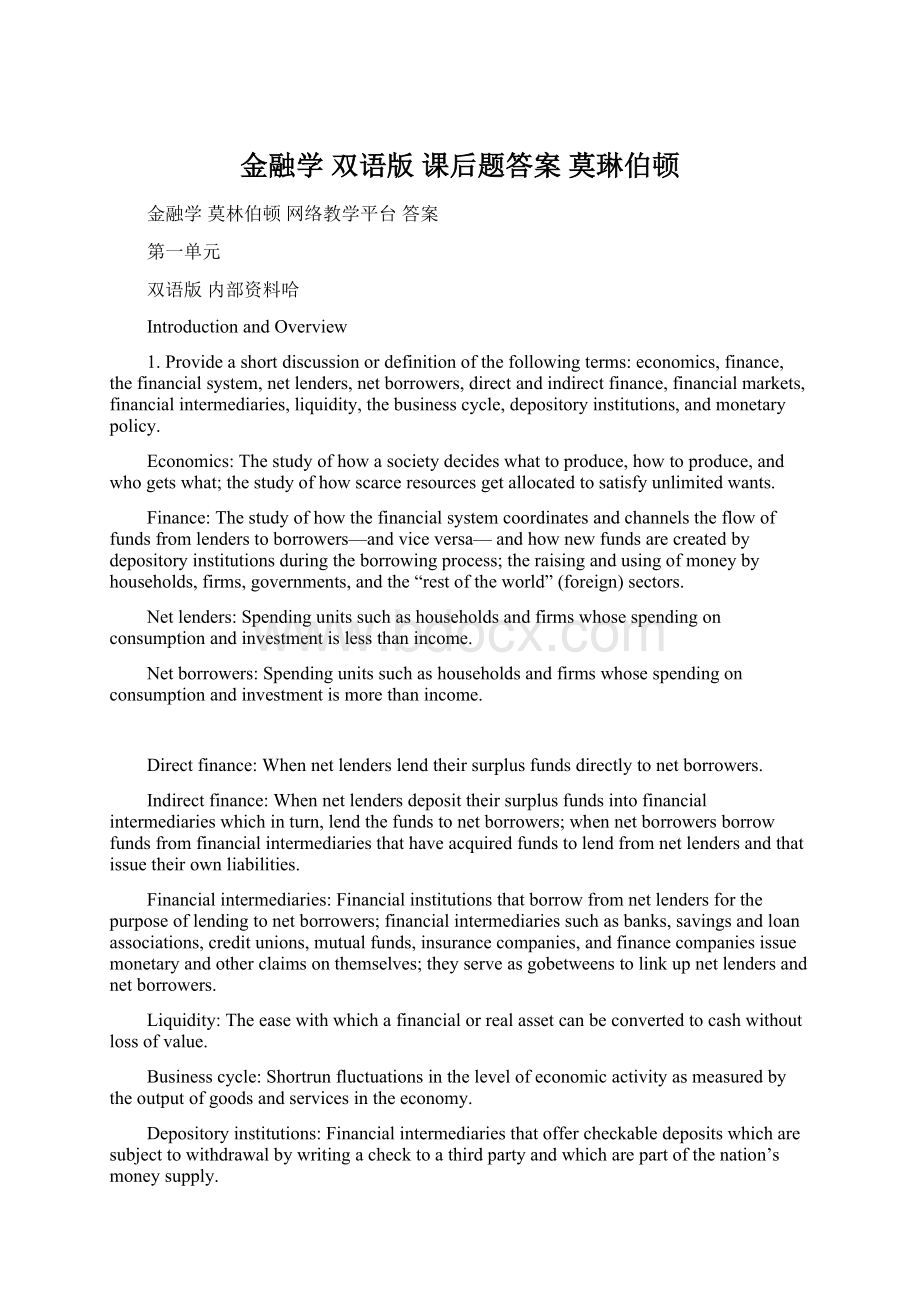金融学 双语版 课后题答案 莫琳伯顿.docx
《金融学 双语版 课后题答案 莫琳伯顿.docx》由会员分享,可在线阅读,更多相关《金融学 双语版 课后题答案 莫琳伯顿.docx(13页珍藏版)》请在冰豆网上搜索。

金融学双语版课后题答案莫琳伯顿
金融学莫林伯顿网络教学平台答案
第一单元
双语版内部资料哈
IntroductionandOverview
1.Provideashortdiscussionordefinitionofthefollowingterms:
economics,finance,thefinancialsystem,netlenders,netborrowers,directandindirectfinance,financialmarkets,financialintermediaries,liquidity,thebusinesscycle,depositoryinstitutions,andmonetarypolicy.
Economics:
Thestudyofhowasocietydecideswhattoproduce,howtoproduce,andwhogetswhat;thestudyofhowscarceresourcesgetallocatedtosatisfyunlimitedwants.
Finance:
Thestudyofhowthefinancialsystemcoordinatesandchannelstheflowoffundsfromlenderstoborrowers—andviceversa—andhownewfundsarecreatedbydepositoryinstitutionsduringtheborrowingprocess;theraisingandusingofmoneybyhouseholds,firms,governments,andthe“restoftheworld”(foreign)sectors.
Netlenders:
Spendingunitssuchashouseholdsandfirmswhosespendingonconsumptionandinvestmentislessthanincome.
Netborrowers:
Spendingunitssuchashouseholdsandfirmswhosespendingonconsumptionandinvestmentismorethanincome.
Directfinance:
Whennetlenderslendtheirsurplusfundsdirectlytonetborrowers.
Indirectfinance:
Whennetlendersdeposittheirsurplusfundsintofinancialintermediarieswhichinturn,lendthefundstonetborrowers;whennetborrowersborrowfundsfromfinancialintermediariesthathaveacquiredfundstolendfromnetlendersandthatissuetheirownliabilities.
Financialintermediaries:
Financialinstitutionsthatborrowfromnetlendersforthepurposeoflendingtonetborrowers;financialintermediariessuchasbanks,savingsandloanassociations,creditunions,mutualfunds,insurancecompanies,andfinancecompaniesissuemonetaryandotherclaimsonthemselves;theyserveasgobetweenstolinkupnetlendersandnetborrowers.
Liquidity:
Theeasewithwhichafinancialorrealassetcanbeconvertedtocashwithoutlossofvalue.
Businesscycle:
Shortrunfluctuationsinthelevelofeconomicactivityasmeasuredbytheoutputofgoodsandservicesintheeconomy.
Depositoryinstitutions:
Financialintermediariesthatoffercheckabledepositswhicharesubjecttowithdrawalbywritingachecktoathirdpartyandwhicharepartofthenation’smoneysupply.
Monetarypolicy:
TheFed’sefforttopromotetheoverallhealthandstabilityoftheeconomy.
2.Somepeoplehavemoney;somepeopleneedmoney.Explainhowthefinancialsystemlinksthesepeopletogether.
Netlendersdepositsurplusfundsintofinancialintermediariesthatinturnlendthefundstonetborrowers.Netlendersgaininterestpaymentsfromthefinancialintermediariesfortheuseoftheirfunds.Netborrowersmakeinterestpaymentstothefinancialintermediariesfortheuseoftheborrowedfunds.Theprofittofinancialintermediariesisthedifferencebetweenthecostoftheirliabilitiesandtheearningsontheirloansandinvestments.
5.Whydofinancialintermediariesexist?
Whatservicesdotheyprovidetothepublic?
Areallfinancialinstitutionsfinancialintermediaries?
Financialintermediariesexisttolinkupnetlendersandnetborrowersandtohelpminimizethetransactionscostsassociatedwithborrowingandlending.Financialservicesprovidedbyfinancialintermediariesincludeappraisinganddiversifyingrisk,offeringamenuoffinancialclaimsthatarerelativelysafeandliquid,andpoolingfundsfromindividualnetlenders.Notallfinancialinstitutionsarefinancialintermediaries.Financialintermediariesareatypeoffinancialinstitutionthatissueclaimsonthemselves.Otherfinancialinstitutions,suchasstockandbondbrokersmerelylinkupnetlendersandnetborrowersforafeeanddonotissueclaimsonthemselves.
8.WhydoestheFedmonitortheeconomy?
WhatactionscantheFedtaketoaffecttheoverallhealthoftheeconomy?
TheFedmonitorstheeconomyinordertopromotetheoverallhealthandstabilityoftheeconomy.TheFedcaninfluencetheeconomythroughmonetarypolicy.TheFedimplementsmonetarypolicytoaffectthelevelofinterestratesandcreditavailability.Wheninterestratesdecreaseandcreditavailabilityincreases,thelevelofeconomicactivityspeedsup.Wheninterestratesincreaseandcreditavailabilitydecreases,thelevelofeconomicactivityslowsdown.
CHAPTER2
PrinciplesofMoney
1.Discussordefinebrieflythefollowingtermsandconcepts:
meansofpayment,storeofvalue,unitofaccount,barter,monetaryaggregates,liquidity,domesticnonfinancialdebt,electronicfundstransfersystem,andrisk.
Meansofpayment:
Somethingthatisgenerallyacceptedandusedtomakepayments.
Storeofvalue:
Somethingthatretainsitsvalueovertime.
Unitofaccount:
Astandardizedaccountingunit,suchasthedollar,whichisthestandardmeasureofvalue.
Barter:
Tradinggoodsforgoodsinanexchangeeconomy.
MonetaryAggregates:
Themeasuresofmoney,includingMI,M2,M3,andL,whichtheFedkeepstrackofandmonitors.
Liquidity:
Theeasewithwhichanon-monetaryassetcanbeconvertedtomoneywithoutlossofvalue.
DomesticNonfinancialDebt:
Totalcreditmarketdebtowedbythenonfinancialsectorandaccumulatedinthepastandpresentyears;includesthedebtowedbythehousehold,nonfinancialbusiness,government,andrestoftheworld(foreign)sectors.
EFTS(ElectronicFundsTransferSystem):
Thetransferoffundstothirdpartiesinresponsetoelectronicinstructionsratherthaninstructionswrittenonpaperchecks.
Risk:
Thepossibilityoffinancialassetslosingvalue.
2.Whatarethefunctionsofmoney?
Whichfunctiondoyouthinkismostimportant?
Thefunctionsofmoneyaretoserveasameansofpayment(mediumofexchange),aunitofaccount,andastoreofvalue.
Themostimportantfunctionofmoneyistoserveasameansofpayment(mediumofexchange).Thus,itiscriticalthatmoneyisgenerallyacceptedtomakepayments.Withoutagenerallyacceptedmeansofpayment,exchangeisverycostly.Foranexchangetotakeplace,therewouldhavetobeadoublecoincidenceofwantswherethepersonyouwishedtobuyfromwantedwhatyouwereofferinginexchange.
5.HowdoestheFedcalculateM1,M2,M3,andDNFD?
Aretheseaggregatesallmoney?
Whyorwhynot?
Whichcontainsthemostliquidassets?
Whichissmallest?
Whichislargest?
TocalculateM1,M2,M3,andDNFD,wemerelyadduptheitemsincludedintheaggregateasfollows:
M1=currencyinthehandsofthepublic+demanddepositsatcommercialbanks+othercheckabledeposits+travelers’checks
M2=M1+smallsavingsandtimedeposits(lessthan$100,000),includingmoneymarketdepositaccounts+individualmoneymarketmutualfunds
M3=M2+largetimedeposits+termrepurchaseagreementsandtermEurodollars+institutionalmoneymarketmutualfunds
DNFD=creditmarketdebtoftheU.S.Governmentandstateandlocalgovernments+corporatebonds+mortgages+consumercredit(includingbankloans)+otherbankloans+commercialpaper+otherdebtinstruments
AlloftheseaggregatesexceptDNFDareameasureofmoney.M1isthenarrowestmeasureofmoneyandthesmallestaggregate.M1isgenerallyusedfortransactionsandcontainsthemostliquidassets—assetsthataremoneyperse.M2andM3areprogressivelybroadermeasuresofmoneythatincludeM1andothernearmoneyassets.Forexample,M2containseverythinginM1plussomeotherhighlyliquidnearmonies.M3containseverythinginM2plusotherlessliquidnearmoneysubstitutes.DNFDisthelargestaggregatebutmanyoftheitemsinDNFDarenotmoneyornearmonies.DNFDisthebroadestmeasureofnonfinancialcreditinthedomesticeconomy.
10.Zotoisaremoteislandthathasexperiencedrapideconomicgrowth.Incontrast,Zahaisanislandwheregrowthhasbeensluggishandthelevelofeconomicactivityremainslow.Howcouldtheexistenceofmoneyhaveaffectedthesetwooutcomes?
Sincemoneyfacilitateseconomicdevelopment,onewouldsuspectthatZotohasasophisticatedandadvanced“money,”whileZahareliesmainlyonbarter.Theexistenceofmoneycouldexplainthedifferinggrowthrates.
CHAPTER3
TheRoleofMoneyandCredit
2.Brieflydefinetheinterestrate,reserves,therequiredreserveratio,theinflationrate,andnominalGDP.
InterestRate:
Thecosttoborrowersofobtainingmoneyandthereturn(oryield)ofmoneytolenders.
Reserves:
AssetsthatareheldbydepositoryinstitutionsaseithervaultcashorreservedepositaccountswiththeFed.
RequiredReserveRatio:
Depositoryinstitutionsmusthavereserveassetsequaltoacertainpercentageofdepositliabilities;therequiredreserveratioisthatpercentage.
TheInflationRate:
Therateofchangeofapriceindex,suchastheconsumerpriceindex.
NominalGDP:
Thequantityoffinalgoodsandservicesproducedinaneconomyduringagiventimeperiodandvaluedattoday’sprices.
8.Whatarethesourcesofcredit?
Explainthefollowingstatement:
“Themoneysupplyismeasuredatapointintimewhiletheflowofcreditismeasuredovertime.”
Creditcomesfromdepositoryinstitutions,otherfinancialintermediaries,andotherfinancialandnonfinancialinstitutions.Themoneysupplyisastock,whilecreditisaflow.Flowsovertimeleadtochangesinstocksmeasuredatdifferentpointsintime.Likewise,changesinstocksmeasuredatdifferentpointsintimeresultfromflowsovertime.
11.Explainthedifferencebetweenmoneyandcredit.Giveanexampleofeach.
Moneyisanythingthatfunctionsasameansofpayment,unitofaccount,andstoreofvalue.Creditistheflowofmoneyinagiventimeperiodfromnetlendersorfinancialintermediariestonetborrowers.Currencyismoneywhereasaloaniscredit.
CHAPTER4
FinancialMarkets,Instruments,andMark